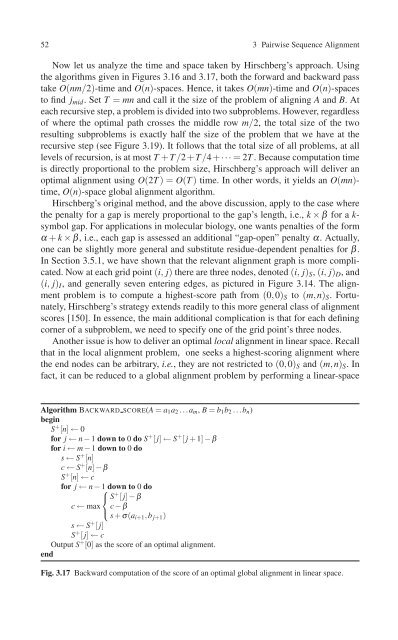You also want an ePaper? Increase the reach of your titles
YUMPU automatically turns print PDFs into web optimized ePapers that Google loves.
52 3 Pairwise <strong>Sequence</strong> Alignment<br />
Now let us analyze the time and space taken by Hirschberg’s approach. Using<br />
the algorithms given in Figures 3.16 and 3.17, both the forward and backward pass<br />
take O(nm/2)-time and O(n)-spaces. Hence, it takes O(mn)-time and O(n)-spaces<br />
to find j mid . Set T = mn and call it the size of the problem of aligning A and B. At<br />
each recursive step, a problem is divided into two subproblems. However, regardless<br />
of where the optimal path crosses the middle row m/2, the total size of the two<br />
resulting subproblems is exactly half the size of the problem that we have at the<br />
recursive step (see Figure 3.19). It follows that the total size of all problems, at all<br />
levels of recursion, is at most T +T /2+T /4+···= 2T . Because computation time<br />
is directly proportional to the problem size, Hirschberg’s approach will deliver an<br />
optimal alignment using O(2T )=O(T ) time. In other words, it yields an O(mn)-<br />
time, O(n)-space global alignment algorithm.<br />
Hirschberg’s original method, and the above discussion, apply to the case where<br />
the penalty for a gap is merely proportional to the gap’s length, i.e., k × β for a k-<br />
symbol gap. For applications in molecular biology, one wants penalties of the form<br />
α + k × β, i.e., each gap is assessed an additional “gap-open” penalty α. Actually,<br />
one can be slightly more general and substitute residue-dependent penalties for β.<br />
In Section 3.5.1, we have shown that the relevant alignment graph is more complicated.<br />
Now at each grid point (i, j) there are three nodes, denoted (i, j) S , (i, j) D , and<br />
(i, j) I , and generally seven entering edges, as pictured in Figure 3.14. The alignment<br />
problem is to compute a highest-score path from (0,0) S to (m,n) S .Fortunately,<br />
Hirschberg’s strategy extends readily to this more general class of alignment<br />
scores [150]. In essence, the main additional complication is that for each defining<br />
corner of a subproblem, we need to specify one of the grid point’s three nodes.<br />
Another issue is how to deliver an optimal local alignment in linear space. Recall<br />
that in the local alignment problem, one seeks a highest-scoring alignment where<br />
the end nodes can be arbitrary, i.e., they are not restricted to (0,0) S and (m,n) S .In<br />
fact, it can be reduced to a global alignment problem by performing a linear-space<br />
Algorithm BACKWARD SCORE(A = a 1 a 2 ...a m , B = b 1 b 2 ...b n )<br />
begin<br />
S + [n] ← 0<br />
for j ← n − 1 down to 0 do S + [ j] ← S + [ j + 1] − β<br />
for i ← m − 1 down to 0 do<br />
s ← S + [n]<br />
c ← S + [n] − β<br />
S + [n] ← c<br />
for j ← n − 1⎧<br />
down to 0 do<br />
⎨ S + [ j] − β<br />
c ← max c − β<br />
⎩<br />
s + σ(a i+1 ,b j+1 )<br />
s ← S + [ j]<br />
S + [ j] ← c<br />
Output S + [0] as the score of an optimal alignment.<br />
end<br />
Fig. 3.17 Backward computation of the score of an optimal global alignment in linear space.

















